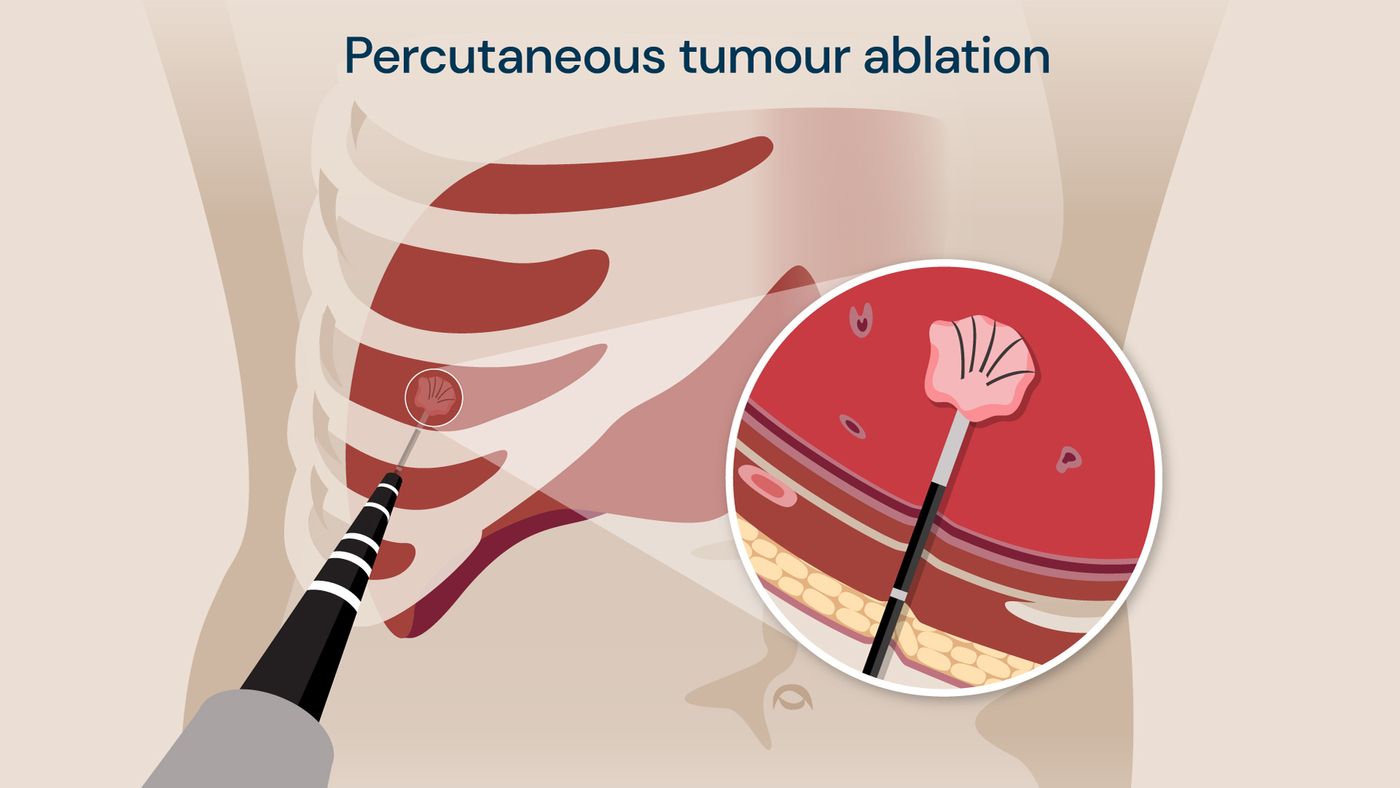What is tumour ablation for lung cancer?
At Royal Brompton and Harefield hospitals, we use a minimally invasive treatment called tumour ablation to treat some forms of lung cancer.
Tumour ablation uses either heat (thermal ablation) or extreme cold (cryoablation) to destroy lung cancer cells. Ablation means ‘destroy’.
Who is tumour ablation suitable for?
The type of tumour ablation your doctor recommends for your treatment plan will depend on your age, overall health, and stage of lung tumour (its size, location and whether it has spread to other parts of your body).
You may be recommended tumour ablation if:
- surgery is not suitable for your lung cancer
- you only have a few small tumours in your lungs
- the tumour location in your lungs would be difficult to reach with surgery
Tumour ablation can be used as part of a treatment plan for early-stage lung cancer to achieve complete remission (where all the signs and symptoms of lung cancer go away).
Thermal ablation vs cryoablation
Thermal ablation
Thermal ablation refers to the practice of destroying lung tumours using heat. This is particularly suitable for people with early-stage lung cancer, or for people with lung tumours which are too small to be detected with surgery. The forms of thermal ablation which are typically used for the treatment of lung cancer tumours are microwave ablation, cryoablation and radiofrequency ablation.
Radiofrequency ablation
Radiofrequency ablation kills cancer cells with heat produced by radio waves. The procedure is carried out percutaneously with needles inserted through the skin directly into your tumour, before an electrical current is passed through the needle. This heats up the cancer cells in your lung tumour, destroying them.
Microwave ablation
Microwave ablation is administered via a needle through the skin, but uses high frequency microwave energy to create heat, instead of the electrical current used in radiofrequency ablation. The use of microwave energy leads to shorter ablation times. If needed, you can have microwave ablation treatment several times, and you can also have it in conjunction with other treatments for lung cancer.
Cryoablation
Cryoablation refers to the practice of destroying cancer cells by freezing them. Cryoablation is usually recommended if you are not suitable for surgical removal of your tumour. Cryoablation may also be recommended when percutaneous microwave ablation is not an option due to the location of the tumour.
The treatment is administered by passing one or more needles through the skin into the lung, the needles tips freeze the cancer cells. Cryoablation can be used both to completely remove cancer cells.
How is tumour ablation performed?
Percutaneous tumour ablation
A small probe is placed through the skin (percutaneously) into the cancer under the guidance of medical imaging, and heat or extreme cold is used to treat the tumour.

Percutaneous tumour ablation involves placing a probe through the skin into the lung, in order to provide treatment to the tumour directly
Heat therapy may be used in percutaneous tumour ablation for deeper lung tissues (where there is a lot of lung tissue surrounding the tumour). Cryoablation (with freezing temperatures) may be used near the delicate outer linings of the lungs.
Both heat therapy and cryoablation procedures are usually performed with general anaesthetic (while you are asleep) and take approximately an hour to carry out.
However, our specialists have recently developed an “awake ablation” procedure for patients who are not suitable for a procedure under general anaesthetic, either due to medical reasons or personal preference. Awake ablation relies on local anaesthetic with only the specific area numbed during the procedure. This shortens the procedure and recovery times.
Our awake ablation technique won the coveted LaingBuisson award in 2022 for improving healthcare outcomes, as it offers patients an option to remove their lung tumour with a minimally invasive technique when this was not previously possible.
Percutaneous (through the skin) tumour ablation is a reliable, successful treatment for lung tumours. At Royal Brompton Hospital, the local tumour control rate (defined as cancer not returning at the site of treatment) is 93.1%, with 97% of patients experiencing minor or no complications.
What are benefits of tumour ablation for lung cancer?
Tumour ablation for lung cancer, as an alternative to surgery, has numerous benefits including:
- minimally invasive with quicker recovery
- highly precise, localised treatment
- repeatable, if required
- suitable for inoperable cases
- can be used in combination with other treatments
What are the risks of tumour ablation for lung cancer?
Tumour ablation for lung cancer comes with some risks.
Risks associated with percutaneous lung tumour ablation include:
- bleeding due to percutaneous probe insertion
- pneumothorax (air collects outside the lung)
- infection either at probe insertion site, or in the lung
- potential for remaining cancer cells
- fever and fatigue during the recovery period
Your consultant will discuss the risks and benefits of tumour ablation in relation to your cancer, its stage and location within the lung. You will decide together whether ablation is used in combination with other treatments, and discuss whether it is used for curative or symptomatic treatment.
Related services
-
Diagnostic tests for lung conditions
Our advanced, high-quality diagnostic facilities can help rapidly diagnose lung conditions.
-
Lung cancer
Lung cancer is a condition caused when the cells that make up the tissue of the lungs become abnormal and grow into a tumour.
-
Lung cancer risk assessment
Our world-leading specialists can assess your risk of developing lung cancer during a consultation.
-
Lung health assessment
Our lung health assessment service is accessible to patients with a range of symptoms, including breathlessness, cough, chest pain, and wheezing.
Locations
We deliver this service in the following hospitals:
Specialists
At Guy’s and St Thomas’ Specialist Care, the following specialists can provide this service:
- Dr Carole Ridge, consultant cardiothoracic and interventional radiologist
- Professor Simon Padley, consultant radiologist
- Dr Emily Bartlett, consultant radiologist
- Professor Pallav Shah, consultant physician in respiratory medicine